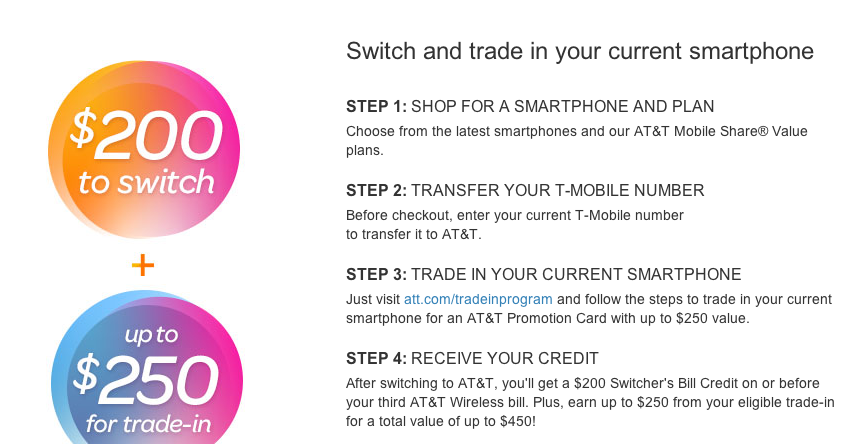AT&T Offers “Up To” $450 For T-Mobile Customers To Switch, But Is It Worth It?
 You know those former couples who broke up before getting married and now one of them is a little too obsessed with how the other is doing? That seems to be the deal with AT&T and T-Mobile, with the larger wireless provider now trying to seduce customers away the smaller company with the lure of hundreds of dollars in credits. But is the offer worth making the switch?
You know those former couples who broke up before getting married and now one of them is a little too obsessed with how the other is doing? That seems to be the deal with AT&T and T-Mobile, with the larger wireless provider now trying to seduce customers away the smaller company with the lure of hundreds of dollars in credits. But is the offer worth making the switch?
The deal, sort-of outlined here on the AT&T website, is that AT&T will offer current T-Mobile customers up to $250 in trade-in credit for their existing phone (note the “up to” part), and a $200 bill credit for switching. There is also just a straightforward $200 bill credit for customers who switch and bring their own phone with them, since T-Mobile and AT&T networks are compatible.
WHAT DOES “UP TO” MEAN?
AT&T will take your old T-Mobile phone off your hands for “up to” $250, meaning that this is the maximum you will receive in trade-in value. Because the actual worth of a traded-in phone will vary greatly depending on the type of phone and its condition, it makes sense that AT&T puts this caveat on the deal, but trying to actually figure out what your phone is worth is virtually impossible.
AT&T has what should be a helpful and easy trade-in value calculator, but it is anything but user-friendly. Not only does it require you to sort through an alphabet soup of model names that only people in the wireless business could understand with ease, it then requires you to put in your device’s EIN and, most bizarrely, your AT&T phone number… which doesn’t help if you’re a T-Mobile customer.
A GOOD TRADE?
Assuming you get the maximum credit of $250 for your traded-in T-Mobile phone, note that this credit must be applied to a new full-price device, as AT&T does not want you to sign up for a 2-year contract and get a discounted, subsidized phone. Rather, you have the option of paying full retail, joining the AT&T Next trade-in program (for which you pay off the full price of the phone in monthly installments), or bring your own phone (more on that below).
That might seem overly restrictive to some, but it is worth pointing out that those are your only options on T-Mobile as well, since it was the first of the major carriers to do away completely with subsidized phone prices.
This is all to say that if you make this switch and put credit that toward a new Samsung Galaxy S 4, you’re not putting $250 toward the $250 price charged to new and renewing customers who sign a two-year contract; you’re putting it toward the $695 charged for an out-of-contract device.
While T-Mobile would have made you pay that full price as well, it does have the monthly installment plan that spreads the cost out over two years. AT&T has that as well, but only through the AT&T Next program.
SHORT-TERM REWARD VS. LONG-TERM SAVINGS
Let’s just look at the $200 bill credit that any T-Mobile defector would get, whether she brings her phone or does the trade-in. Everyone loves to get money, but the big question to ask is whether that $200 is really worth the switch?
T-Mobile’s unlimited data plan is $70/month, while the closest AT&T plan (in terms of monthly rate) is $80/month for customers who own their own phone or are part of the Next program, but it caps data usage at 2 GB/month.
Assuming you are not a data hog and can live with the 2 GB limit, the $200 credit would last 20 months before you begin to feel the higher price of the AT&T rates.
Or say you are switching from T-Mobile’s 2.5 GB/month plan that currently costs $60. Then the $200 credit doesn’t even last a year before you’re paying the full amount of the AT&T bill.
WHY SOME PEOPLE WILL STILL SWITCH
There’s a reason T-Mobile’s prices are so much lower than their competitors’ — they have to be. The company is currently a distant fourth place and is once again in the news as being a takeover target by Sprint, Dish Network, Gordon Gekko, and Weyland-Yutani. (Okay, so maybe I just dreamt of those last two.) Though T-Mobile has maintained its position as a lower-cost, disruptive presence in an increasingly consolidated market, who’s to say what the eventual new ownership might be planning?
Additionally, T-Mobile continues to lag behind the competition in its roll-out of LTE coverage, though its recent purchase of Metro PCS has helped.
While many T-Mobile customers are happy with the service and price they receive (or as happy as any wireless customer is with his provider — which isn’t saying much), some folks will see this as an opportunity to jump ship to a provider with a faster network and a less fuzzy future.
Want more consumer news? Visit our parent organization, Consumer Reports, for the latest on scams, recalls, and other consumer issues.

